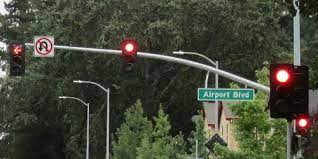Have you ever had the experience of being in an unfamiliar part of our splendid metropolitan area, trying to follow the instructions on your “whiz-bang” (my father’s nickname for smartphone GPS guidance), feeling the pressure of your schedule and the impatience of drivers around you, and deciding to ‘make your move’ in a complicated intersection (hoping it’s the correct street), looked up just in time to see the traffic signal change to red while you are still moving mid-intersection? In addition to some embarrassment and anxiety about the possibility of being hit by cross-traffic, one likely reaction would be, “I hope there was no red-light camera.”
It would be a natural response. First, because there are so many red-light cameras and speed cameras in our area – the District of Columbia and Silver Spring were two of the top three localities for traffic cameras in the whole United States in a recent statistical list, and there are more every month. Secondly, those camera fines can be costly as well as inescapable: the “legal” presumption is that the camera is always right. Thirdly, no conscientious person enjoys being responsible for illegal, incorrect, or inadvisable behavior, much less being observed while doing it. But it does happen.
So there you are, doing something you didn’t want to do and wish you hadn’t done, and your ‘hope’ is that there is no camera recording it. What are the grounds for your hope? Well, statistics, first of all: there cannot be functional red-light cameras in every intersection, even in DC; so there is an arithmetic chance that this was an intersection without one. Secondly, your own ignorance: this is an unfamiliar intersection, and you have not already discerned it to be monitored by a camera (unlike our own familiar, fabulous Four Corners), and this leaves open the intellectual possibility that it is not. These are grounds for some sort of hope, but they are flimsy.
Traffic cameras are inhuman and themselves give no ground for natural hope. At least a traffic cop, a real person, allows room for the possibility of mercy when we have committed a moving violation; and that is a valid ground for hope. We can hope in a person.
This week we began the season of Lent, the Great Fast of Christians everywhere in preparation for the Feast of Our Lord’s Resurrection. The awareness that comes to me this year as we return to this recurring time we all know so well and sometimes dread, is that Lent is a long and demanding, communal act of hope.
On our good days at least, we are conscientious enough to wish to avoid behavior that is illegal, incorrect, or inadvisable in the sight of God, yet we are frank enough to realize that we have failed to do that. We are also capable of nurturing the false reassurance that nobody noticed, nobody minded, or nobody was actually hurt, up to the point when we admit to ourselves that is impossible. Omniscient God, not notice? The God Who has worked over the millennia of salvation history to reveal Himself and His Divine Law, not mind? The Father Who sacrificed His only begotten Son, convinced that nobody was hurt?
We have failed, and we know it. With that utterance of dismay, that tinge of grief, comes the admission, and we crack open the casing that contains what makes hope possible: repentance, and the desire for mercy; a chance, the possibility of trying again, of doing better next time and henceforth. Do not define us by our bad actions! We can be good, we can be holy, we can make you delight in us and in our deeds, oh God, really we can; just give us the chance, the grace to try again.
Lent reminds us that our hope is in a person, not our perfection. That person is the Son of God, Jesus Christ, Who is the Divine Mercy, Who invites us to turn to Him. He has seen everything, all that we have done and failed to do; He has heard all of the excuses we nurture within our minds. He has forgotten nothing, least of all the promises we made and quickly discarded. And yet, His eyes are on us, His arms extended. Turn to me, He says, return to me.
He is our hope.
Monsignor Smith



